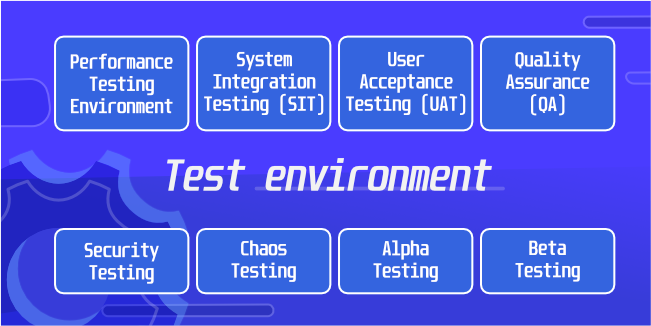Software development environment

The development environment is intended for software development, modification, testing, and maintenance. However, some developers claim that the testing possibilities offered by development environments outweigh other functions. Software testing is essential to the system development cycle (SDLC). Tests are performed to ensure the code runs efficiently before it is released to users in production. Testing is the best way to check if a feature is likely to crash or not work in a production environment. For this, specific development environments are needed.
However, the importance of other development environments, which also play a crucial role in the application development process, cannot be underestimated. Nowadays, it is impossible to imagine creating and implementing a successful application without using programming environments.
What is a Software Development Environment?
A software development environment (SDE) is a set of tools that automate or augment the tasks involved in creating software. An SDE helps with the long-term maintenance of software at a large scale. Programming tasks include group and project management and configuration management.
A software development environment is a platform that helps you work with specific application platforms through an intelligent toolkit. With SDE, you don't need to use many tools and plugins, which is cumbersome and often frustrating. All you need is one but a fully functional device.
A given platform is considered an SDE if it meets the following conditions:
- has text editor or graphic user interface (GUI) improve programming
- integrates with other platforms, NOT using a separate plugin
- allow for the development of software applications, integration testing, and live product release.
On the other hand, an integrated development environment is a specialized kind of SDEs that incorporates all of a project's toolkits for a particular platform.
Types of Software Development Environments

There are 4 main types of software development environments:
- Development Environment
- Test Environment
- Staging Environment
- Production Environment.
Development Environment
The development environment serves as a workspace for software developers for coding and other software development project-related processes. In the greatest simplification, the development environment is a set of tools for creating, testing, and debugging files.
It is a place where changes are made to the code, and all the necessary tools make it possible for the software development team to apply changes under controlled conditions without worrying about the impact of these changes on end users. It is because, thanks to working in this environment, developers can be sure that all application functions will work as planned before they reach the users.
Such an environment may exist locally (when a tiny number of people work on the project), or it may be placed on a server (when many developers participate in the project). In the latter option, each change is sent to the repository on an ongoing basis.
The main advantage of the programming environment is the increase in developer productivity and the provision of the high-quality developed software. It is also essential to safely apply changes to the code without the risk of unnecessary errors in the finished product.
Version control systems have recently taken the place of the development stage: GitHub and its competitors. In the cloud, they host code in public and private repositories. It provides for the simplest installation of this system.
Test Environment
The test environment is used - as the name suggests - to test the quality of the application. It allows developers to identify any errors and fix them immediately so that they do not have a negative impact on end users. Software testing allows you to test how your code will behave in a live environment.
The testing environment is a critical aspect of the software development process. Developers can use test environments to check for and fix faults and increase the overall quality of their apps. Several types of test environments are available to analyze distinct software components. The following are some of the most prevalent types of test environments:
- Performance Testing Environment
- System Integration Testing (SIT)
- User Acceptance Testing (UAT)
- Quality Assurance (QA)
- Security Testing
- Chaos Testing
- Alpha Testing
- Beta Testing

Performance Testing Environment
In this environment, developers can see how responsive an application is to interaction. Testing various app areas in this way - such as page load speed, input processing, stability, and reliability - helps give a clear understanding of its quality.
System Integration Testing (SIT)
It is widespread for software developers to create modules that can run independently of each other. However, at some point in the development of a project, all these modules need to be linked and integrated successfully.
System integration testing is chiefly done to ensure that code modules, client and server applications, and individual apps can all communicate with each other properly according to their dependencies. Additionally, this process checks that shared databases are working correctly.
User Acceptance Testing (UAT)
User acceptance or user acceptance tests ensure that the developed solution meets end-user needs. It is the final phase of testing. The application will be transferred to the production environment if there are positive results. However, if it turns out that the application does not satisfy the users, then corrections will be necessary.
Quality Assurance (QA)
In this test environment, you can check whether the created application is a high-quality application. Development teams also have the opportunity to compare the new software with its previous version to check whether the new application meets the previously set goals..
Security Testing
Application data security is a critical issue for both users and investors. Testing teams may use penetration testing to ensure that all layers of a software's security are intact. Specialists perform these types of tests to analyze the application's resistance to malicious programs, viruses, cybercriminals, and other threats. The authorization and authentication processes are also verified.
Chaos Testing
Chaos Testing or Chaos Engineering is a highly specialized approach to system integrity testing. It proactively simulates and identifies failures in your environment before they lead to unplanned downtime or a negative user experience. This environment demonstrates areas where your application might die or end users may be harmed.
Alpha Testing
When all modules have already been integrated, it is necessary to test the application completely. Application developers must ensure that the application works by the expectations of both the client and the users.
Beta Testing
Beta tests are for manual application testing by real users, but their number is limited. These tests are used to find and report any overlooked issues that the developers may have. Some flaws only manifest during production, which necessitates the use of an open accessibility test environment: hence the necessity for a beta version of the program.
Staging Environment
The stage settings are almost a carbon copy of the software testing production environment. Like production, staging environments are used to check code, builds, and updates for quality assurance. The staging environment needs identical hardware, server, database, and cache settings. Everything in the staging setting should be as comparable to the real thing as possible to guarantee that the application functions correctly. Staging environments conduct tests that prevent production issues, saving time and hassle by identifying potential problems before they occur.
Production Environment
Production environments, where users interact with the code, are very different from deployment environments. Careful planning is critical when introducing new code to a production environment so that there is no interruption in service. You may need to use special strategies like having one server running old code and another running new code. Then you can redirect traffic to the new. It's also important to notify users ahead of time about any potential outages that might occur during the process.
Trends in the software development environment

Development environments are also changing with the advancement of technology. The change is related both to the development of programming languages and the increasing expectations of users. It is also associated with specific trends in the industry. It is a natural process that has been going on for many years. Below are 4 types of environments that have developed due to the factors mentioned above:
- Language-oriented environments
- Structure-oriented environments
- Toolkit environments
- Method-based environments.
Language-oriented environments
Development environments like these are built around one language, so they come with a toolkit suitable for programming in that language. They're usually very interactive and can support large-scale projects.
Structure-oriented environments
Structure Oriented Environments are places where users can directly manipulate the structures around them. These techniques don't require a specific language, originally allowing for creating generators in these environments.
Toolkit environments
This term refers to a set of tools that include language-independent support for large programming activities such as version control and configuration management.
Method-based environments
These types of environments cover the handling of many of the procedures involved in the software development process, such as team management or project management.
Conclusion
Today, it is impossible to imagine a successful development and implementation of a successful application without the use of development environments. A software development environment is a collection of tools that hardware and software engineers use to build software systems. There are several types of development environments, and they are all critical. If you need any help or consultation on this matter, please do not hesitate to contact us.